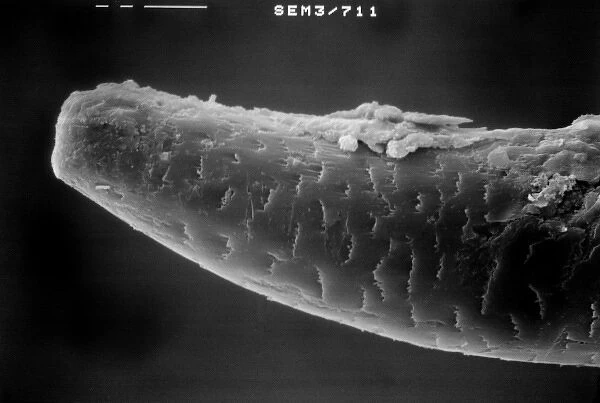Lumbricus terrestris, earthworm
![]()

Wall Art and Photo Gifts from Mary Evans Picture Library
Lumbricus terrestris, earthworm
Scanning electron microscope (SEM) image showing the chaeta/setae - involved in the locomotion on an earthworm
Mary Evans Picture Library makes available wonderful images created for people to enjoy over the centuries
Media ID 8598513
© Mary Evans Picture Library 2015 - https://copyrighthub.org/s0/hub1/creation/maryevans/MaryEvansPictureID/10705279
Annelid Annelida Electron Micrograph Micrograph Microscope Image Scanning Electron Micrograph Scanning Electron Microscope Scanning Electron Microscope Image Sem Image Soil Worm Common Earthworm Earthworm Invertebrata Lumbricus Lumbricus Terrestris Oligochaeta
EDITORS COMMENTS
1. Title: A Closer Look into the World of Earthworms: Chaetae, the Microscopic "Hairs" Powering Earthworm Locomotion 2. Description: This Scanning Electron Microscope (SEM) image showcases the intricate structure of chaetae, also known as setae, on the surface of a common earthworm, Lumbricus terrestris. Belonging to the Annelida phylum, specifically the Oligochaeta class, earthworms are invertebrate worms commonly found in soil. 3. Background: Earthworms play a crucial role in the ecosystem as decomposers, breaking down organic matter and enriching the soil with nutrients. Their body is segmented, with a distinct head and clitellum, which is responsible for producing mucus and slime. 4. Focus on Chaetae: The chaetae, visible in this micrograph, are tiny, hair-like structures covering the earthworm's body. These microscopic appendages serve multiple functions, including locomotion, attachment to the soil, and respiration. The chaetae's unique structure, as seen in this SEM image, allows the earthworm to move efficiently through the soil. 5. Scanning Electron Microscope: The Scanning Electron Microscope (SEM) is an advanced imaging technique that uses a focused electron beam to scan the surface of a sample and generate detailed images. In this instance, the SEM has provided an unprecedented view of the earthworm's chaetae, revealing their complex structure and function. 6. Conclusion: This SEM image of the chaetae on a common earthworm, Lumbricus terrestris, offers a fascinating glimpse into the microscopic world that powers the earthworm's movements and contributes to its essential role in the ecosystem. The intricate details revealed by the Scanning Electron Microscope underscore the beauty and complexity of nature.
MADE IN THE USA
Safe Shipping with 30 Day Money Back Guarantee
FREE PERSONALISATION*
We are proud to offer a range of customisation features including Personalised Captions, Color Filters and Picture Zoom Tools
FREE COLORIZATION SERVICE
You can choose advanced AI Colorization for this picture at no extra charge!
SECURE PAYMENTS
We happily accept a wide range of payment options so you can pay for the things you need in the way that is most convenient for you
* Options may vary by product and licensing agreement. Zoomed Pictures can be adjusted in the Cart.


